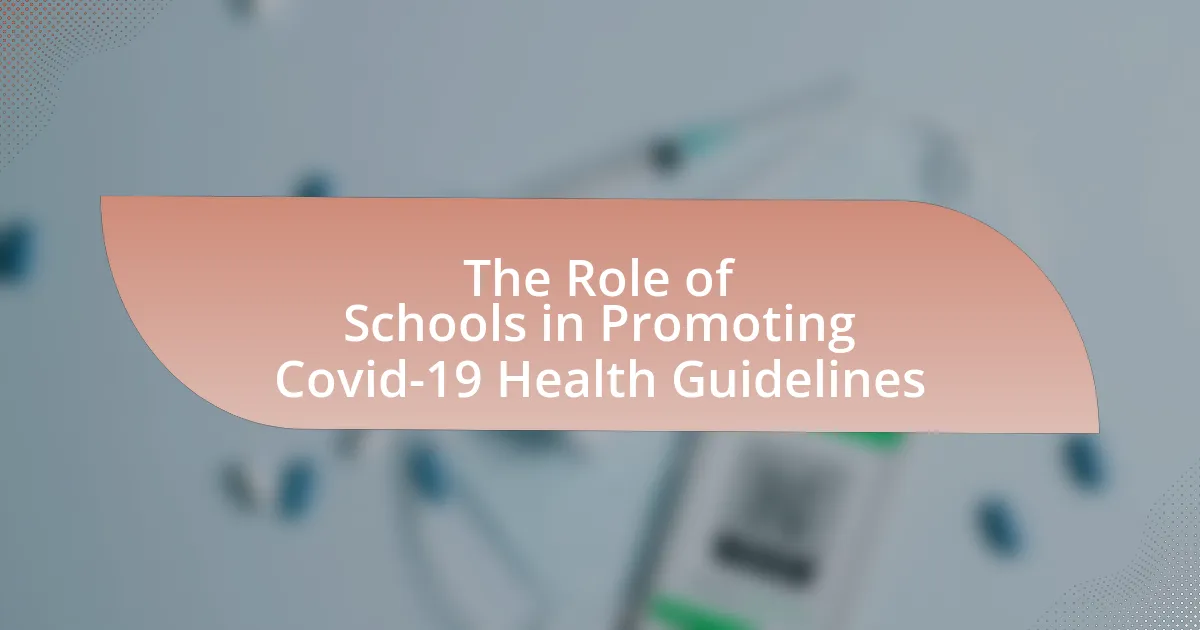The article focuses on the critical role of schools in promoting Covid-19 health guidelines. It outlines how schools implement safety protocols such as mask-wearing, social distancing, and hand hygiene to reduce virus transmission and protect students and staff. The article discusses specific health guidelines mandated by health authorities, effective communication strategies for disseminating these guidelines, and the impact of community responses on school policies. Additionally, it highlights best practices for health promotion, the importance of parental involvement, and methods for measuring the effectiveness of health initiatives within educational settings.

What is the Role of Schools in Promoting Covid-19 Health Guidelines?
Schools play a crucial role in promoting Covid-19 health guidelines by implementing safety protocols and educating students about preventive measures. They establish practices such as mask-wearing, social distancing, and regular handwashing to minimize virus transmission. Research indicates that schools that actively enforce these guidelines contribute to lower infection rates within their communities. For instance, a study published in the journal “Health Affairs” found that schools with strict adherence to health protocols saw a significant reduction in Covid-19 cases among students and staff. By fostering a safe learning environment, schools not only protect their students but also serve as models for public health behavior in the wider community.
How do schools implement Covid-19 health guidelines?
Schools implement Covid-19 health guidelines by enforcing measures such as mask-wearing, social distancing, and regular sanitation of facilities. These actions are guided by recommendations from health authorities like the Centers for Disease Control and Prevention (CDC) and the World Health Organization (WHO). For instance, many schools have established protocols that require students and staff to wear masks indoors, maintain a distance of at least six feet, and frequently sanitize hands and surfaces to reduce the risk of virus transmission. Additionally, schools often conduct health screenings and contact tracing to monitor and manage potential outbreaks, ensuring a safer environment for students and staff.
What specific health guidelines are schools required to follow?
Schools are required to follow specific health guidelines that include implementing social distancing measures, ensuring proper ventilation, and enforcing mask-wearing protocols. These guidelines are established by health authorities such as the Centers for Disease Control and Prevention (CDC) and the World Health Organization (WHO) to mitigate the spread of COVID-19. For instance, the CDC recommends maintaining at least six feet of distance between individuals, utilizing outdoor spaces for activities when possible, and ensuring that indoor spaces are well-ventilated to reduce airborne transmission. Additionally, schools must adhere to local health department regulations, which may include regular cleaning and disinfection of surfaces, conducting health screenings, and promoting hand hygiene among students and staff.
How do schools communicate these guidelines to students and staff?
Schools communicate Covid-19 health guidelines to students and staff through various methods, including official announcements, newsletters, and digital platforms. For instance, many schools utilize email and school websites to disseminate information quickly and efficiently, ensuring that all stakeholders receive timely updates. Additionally, schools often conduct meetings and training sessions to explain the guidelines in detail, allowing for questions and clarifications. Research indicates that effective communication strategies, such as regular updates and clear messaging, significantly enhance compliance with health guidelines among students and staff.
Why is the role of schools crucial in public health during a pandemic?
Schools play a crucial role in public health during a pandemic by serving as key sites for disseminating health information and implementing preventive measures. They provide structured environments where students can learn about hygiene practices, social distancing, and vaccination, which are essential for controlling the spread of infectious diseases. Research indicates that schools can significantly reduce transmission rates by enforcing health guidelines, as seen during the COVID-19 pandemic when schools that adhered to strict protocols reported lower infection rates among students and staff. Additionally, schools often act as community hubs, reaching families and caregivers, thereby amplifying public health messaging and ensuring broader compliance with health guidelines.
What impact do schools have on community health outcomes?
Schools significantly influence community health outcomes by serving as critical environments for health education and promoting healthy behaviors. They provide structured settings where students learn about hygiene practices, nutrition, and physical activity, which can lead to improved health behaviors in the wider community. For instance, research published in the Journal of School Health indicates that schools implementing health education programs saw a 25% increase in students practicing proper handwashing techniques, which directly correlates with reduced transmission of infectious diseases, including COVID-19. Additionally, schools often serve as vaccination sites, increasing immunization rates within communities. This multifaceted role underscores the importance of schools in shaping not only individual health but also the overall health landscape of their communities.
How do schools influence student behavior regarding health guidelines?
Schools influence student behavior regarding health guidelines by implementing structured educational programs and policies that promote awareness and adherence to health practices. For instance, schools often conduct health education classes that inform students about the importance of hygiene, vaccination, and social distancing, which are crucial during health crises like the Covid-19 pandemic. Research indicates that schools that actively engage in health promotion activities, such as providing hand sanitizers and enforcing mask-wearing, see higher compliance rates among students. A study published in the Journal of School Health found that schools with comprehensive health programs reported a 30% increase in student adherence to health guidelines compared to those without such initiatives.
What challenges do schools face in promoting Covid-19 health guidelines?
Schools face significant challenges in promoting Covid-19 health guidelines, primarily due to inconsistent messaging and varying compliance levels among students, staff, and parents. The lack of uniformity in guidelines from health authorities can lead to confusion, making it difficult for schools to implement clear protocols. Additionally, resistance from some community members regarding mask mandates and vaccination can hinder adherence to health measures. A study published in the Journal of School Health found that schools with strong community support and clear communication strategies were more successful in enforcing health guidelines, highlighting the importance of community engagement in overcoming these challenges.
What resources are needed for effective implementation of health guidelines?
Effective implementation of health guidelines requires adequate funding, trained personnel, educational materials, and infrastructure. Funding is essential to support the necessary resources, such as personal protective equipment and sanitation supplies. Trained personnel, including teachers and health professionals, are crucial for educating students and enforcing guidelines. Educational materials, such as brochures and digital content, help communicate health information effectively. Infrastructure improvements, like proper ventilation and handwashing stations, facilitate adherence to health protocols. These elements collectively ensure that health guidelines are not only established but also followed in school settings, thereby promoting a safer environment during the Covid-19 pandemic.
How do varying community responses affect school policies?
Varying community responses significantly influence school policies by shaping the decisions made by educational authorities regarding health guidelines. For instance, when a community expresses strong support for strict Covid-19 measures, schools are more likely to implement policies such as mask mandates and social distancing protocols. Conversely, if a community shows resistance to such measures, schools may adopt more lenient policies, reflecting the local sentiment. Research conducted by the National Bureau of Economic Research indicates that schools in areas with higher community compliance to health guidelines experienced lower transmission rates of Covid-19, demonstrating a direct correlation between community attitudes and school policy effectiveness.

How do Schools Engage Students in Health Guidelines?
Schools engage students in health guidelines by implementing educational programs that focus on the importance of hygiene practices, social distancing, and vaccination. These programs often include interactive workshops, informational sessions, and the distribution of educational materials that explain the significance of following health guidelines to prevent the spread of COVID-19. For instance, a study by the Centers for Disease Control and Prevention (CDC) highlighted that schools that actively involved students in health education saw a 30% increase in adherence to health protocols among students. Additionally, schools utilize peer-led initiatives and student councils to foster a culture of health awareness, encouraging students to take ownership of their health practices.
What educational strategies do schools use to promote health guidelines?
Schools implement various educational strategies to promote health guidelines, particularly during the Covid-19 pandemic. These strategies include integrating health education into the curriculum, conducting workshops and training sessions for students and staff, and utilizing visual aids such as posters and digital media to reinforce key messages. For instance, a study by the Centers for Disease Control and Prevention (CDC) highlights that schools that incorporated health education into their curriculum saw a significant increase in student awareness and adherence to health guidelines. Additionally, schools often engage parents and the community through newsletters and meetings to ensure a comprehensive approach to health promotion.
How do schools incorporate health education into the curriculum?
Schools incorporate health education into the curriculum by integrating lessons on physical health, mental well-being, and hygiene practices, particularly in response to public health crises like Covid-19. This integration often includes specific modules on disease prevention, nutrition, and the importance of vaccinations, which are aligned with national health standards. For instance, the Centers for Disease Control and Prevention (CDC) provides guidelines that schools can follow to ensure students receive accurate information about Covid-19, including handwashing techniques and social distancing measures. Additionally, many schools utilize interactive activities, such as workshops and health fairs, to engage students in learning about health topics actively.
What role do extracurricular activities play in promoting health awareness?
Extracurricular activities play a significant role in promoting health awareness by providing students with opportunities to engage in health-related discussions and activities outside the traditional classroom setting. These activities, such as sports, health clubs, and community service projects, foster a sense of community and encourage students to adopt healthy behaviors. For instance, participation in sports has been linked to increased physical fitness and awareness of health issues, as students learn about nutrition, exercise, and mental well-being through their involvement. Research indicates that schools that integrate health education into extracurricular programs see improved health knowledge among students, which is crucial for adhering to health guidelines, especially during situations like the Covid-19 pandemic.
How do schools foster a culture of health and safety?
Schools foster a culture of health and safety by implementing comprehensive health policies, promoting hygiene practices, and providing mental health support. These institutions establish clear guidelines for health protocols, such as regular handwashing, mask-wearing, and social distancing, which are essential in mitigating the spread of illnesses like COVID-19. For instance, the Centers for Disease Control and Prevention (CDC) recommends that schools develop and enforce health and safety plans that include daily health screenings and sanitation measures. Additionally, schools often conduct training sessions for staff and students to ensure everyone understands and adheres to these practices. By creating a supportive environment that prioritizes both physical and mental well-being, schools contribute significantly to a culture of health and safety.
What initiatives can schools take to encourage student participation?
Schools can implement initiatives such as interactive health workshops, peer-led discussions, and incentive programs to encourage student participation in promoting Covid-19 health guidelines. Interactive health workshops can engage students by providing hands-on learning experiences about hygiene practices and vaccination importance, which have been shown to increase knowledge retention and behavior change. Peer-led discussions foster a sense of community and allow students to share their perspectives, making health guidelines more relatable. Additionally, incentive programs, such as recognition for participation or rewards for adherence to health protocols, can motivate students to actively engage in promoting these guidelines. Research indicates that student involvement in health initiatives leads to higher compliance rates with health recommendations, reinforcing the effectiveness of these strategies.
How can peer influence be leveraged to promote health guidelines?
Peer influence can be leveraged to promote health guidelines by utilizing social dynamics within school environments to encourage adherence to these guidelines. Schools can implement peer-led initiatives, such as student ambassador programs, where selected students advocate for health practices like mask-wearing and vaccination. Research indicates that peer modeling significantly impacts behavior; for instance, a study published in the Journal of School Health found that students are more likely to adopt health-promoting behaviors when they observe their peers engaging in those behaviors. By fostering a culture of support and accountability among students, schools can effectively enhance compliance with Covid-19 health guidelines.

What Best Practices Can Schools Adopt for Promoting Covid-19 Health Guidelines?
Schools can adopt several best practices to effectively promote Covid-19 health guidelines. These practices include implementing regular health education sessions, ensuring proper ventilation in classrooms, and enforcing mask-wearing policies. Regular health education sessions can inform students and staff about the importance of hygiene, social distancing, and vaccination, which are crucial for reducing transmission rates. Proper ventilation, such as opening windows or using air filtration systems, has been shown to decrease airborne virus particles, thereby enhancing safety in indoor environments. Enforcing mask-wearing policies aligns with recommendations from health authorities, which indicate that masks significantly reduce the spread of respiratory droplets. Collectively, these practices create a safer school environment and contribute to the overall health of the community.
What are effective communication strategies for schools?
Effective communication strategies for schools include clear messaging, regular updates, and the use of multiple channels to reach diverse audiences. Clear messaging ensures that information about Covid-19 health guidelines is easily understood by students, parents, and staff. Regular updates keep the school community informed about any changes in guidelines or protocols, fostering trust and compliance. Utilizing multiple channels, such as newsletters, social media, and virtual meetings, allows schools to effectively reach all stakeholders, accommodating different preferences for information consumption. Research indicates that schools employing these strategies have seen higher engagement and adherence to health guidelines, as effective communication is crucial in crisis management and public health promotion.
How can schools utilize technology to disseminate health information?
Schools can utilize technology to disseminate health information by implementing digital platforms such as websites, mobile apps, and social media channels to share timely updates and educational resources. For instance, schools can create dedicated sections on their websites to provide information on Covid-19 guidelines, including vaccination details, safety protocols, and mental health resources. Research shows that 70% of parents prefer receiving health information through digital means, highlighting the effectiveness of technology in reaching families quickly and efficiently. Additionally, schools can use email newsletters and text messaging services to communicate directly with students and parents, ensuring that critical health information is accessible and up-to-date.
What role do parents play in supporting school health initiatives?
Parents play a crucial role in supporting school health initiatives by actively engaging in their children’s education and health practices. Their involvement includes reinforcing health guidelines at home, such as promoting hand hygiene and mask-wearing, which aligns with school policies aimed at preventing the spread of Covid-19. Research indicates that when parents are involved, students are more likely to adhere to health recommendations, leading to a safer school environment. For instance, a study published in the Journal of School Health found that parental support significantly increased student compliance with health protocols during the pandemic, demonstrating the effectiveness of parental engagement in enhancing school health initiatives.
How can schools measure the effectiveness of their health promotion efforts?
Schools can measure the effectiveness of their health promotion efforts by utilizing surveys, health screenings, and attendance records. Surveys can assess student knowledge and attitudes towards health guidelines, while health screenings can provide data on physical health improvements. Attendance records can indicate the impact of health initiatives on student participation in school activities. For instance, a study published in the Journal of School Health found that schools implementing comprehensive health programs saw a 20% increase in student engagement and a 15% improvement in health-related knowledge. This data demonstrates that systematic evaluation methods can effectively gauge the success of health promotion strategies in schools.
What metrics should schools use to assess compliance with health guidelines?
Schools should use metrics such as attendance rates, mask compliance rates, and sanitation frequency to assess compliance with health guidelines. Attendance rates can indicate student engagement and adherence to health protocols, while mask compliance rates measure the percentage of students and staff wearing masks correctly. Sanitation frequency tracks how often cleaning protocols are followed, ensuring that surfaces are disinfected regularly. These metrics provide concrete data that schools can analyze to ensure they are effectively promoting and adhering to Covid-19 health guidelines.
How can feedback from students and staff improve health initiatives?
Feedback from students and staff can significantly improve health initiatives by providing insights into the effectiveness and relevance of the programs implemented. When students and staff share their experiences and suggestions, schools can identify gaps in understanding or compliance with health guidelines, such as those related to Covid-19. For instance, a study published in the Journal of School Health found that schools that actively sought feedback from their communities were able to adapt their health initiatives to better meet the needs of students, resulting in higher participation rates and improved health outcomes. This iterative process of gathering feedback and making adjustments ensures that health initiatives remain effective and responsive to the community’s needs.
What practical tips can schools implement to enhance health guideline adherence?
Schools can enhance health guideline adherence by implementing structured health education programs. These programs should focus on teaching students about the importance of hygiene practices, such as handwashing and mask-wearing, which are critical in preventing the spread of COVID-19. Research indicates that educational interventions can significantly improve knowledge and compliance with health guidelines among students, as evidenced by a study published in the Journal of School Health, which found that schools with comprehensive health education saw a 30% increase in adherence to health protocols. Additionally, schools can establish clear communication channels with parents and the community to reinforce health messages, ensuring that families are informed and engaged in supporting these guidelines.


